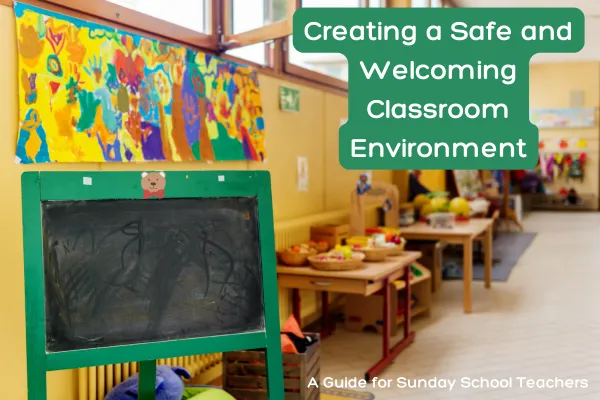
Creating a Safe and Welcoming Classroom Environment: A Guide for Sunday School Teachers
Classroom Makeover
One of my favorite memories of being a Sunday School teacher was having a classroom I could decorate. In the ‘90s and early 2000s, I had a chalkboard, a whiteboard, and a very old overhead projector. I loved that projector. I brought it home and played school at home. If you’re too young to know what an overhead projector is, it was the technology of the day for schools. You could write on transparency sheets on top of the projector, and the light and mirrors would project whatever you were writing onto a screen.
These tools helped me deliver God’s message to my children and made the classroom look like a place of learning.
I did not always have these tools as a Sunday School teacher. We were a very small church. When we moved church out of my aunt and uncle's house and got some space in a shopping strip, my classroom walls were bare—just a room with four white walls. It would be over time before we could add those classroom items.
That said, I could still teach Sunday school when I didn’t have all the tools. I had a few hand-me-down Bible lessons from other churches, which worked fine. Because as I’ve stated previously, God’s word never changes. These lesson plans could be used today if I still had them.
A Safe and Welcoming Classroom
Decorating a classroom may be the exciting part of setting up, but it’s just a tiny part of creating a welcoming classroom. A safe and welcoming classroom environment is the foundation of effective teaching and learning, especially in Sunday School. When children feel secure and accepted, they are more open to engaging with the material and building relationships with their peers and teachers.
Here’s how to create a space that nurtures safety and warmth in your Sunday School classroom.
1. Establish Clear Rules and Expectations 📝
Children thrive in environments where they understand the boundaries and expectations. Clear rules provide structure and help maintain order. At the start of the class, outline simple, age-appropriate rules. Use positive language, such as “Speak kindly” instead of “Don’t yell.” Reinforce these rules consistently and gently remind children when necessary. Consider creating a visual chart with the rules that can be referenced throughout the class.
2. Foster a Culture of Respect and Kindness 🤝
Respect and kindness are essential in building a community where every child feels valued and heard. Model respectful behavior in your interactions with the children and encourage them to do the same with each other. Praise acts of kindness and encourage inclusive play and participation. Activities that promote teamwork and empathy can reinforce these values.
3. Ensure Physical Safety 🦺
A physically safe environment allows children to focus on learning without fear of injury or discomfort. Regularly inspect the classroom for hazards such as loose wires, sharp edges, or unstable furniture. Ensure that the classroom is childproofed, especially for younger children. Keep emergency contact information and a first-aid kit readily accessible. The last thing you need is for a child to get hurt during the one hour you are with them.
4. Create a Welcoming Atmosphere 👋
A welcoming atmosphere helps children feel comfortable and excited to participate in Sunday School. Decorate the classroom with bright colors, engaging visuals, and displays that reflect the diversity of the children in your class. Greet each child warmly as they arrive, using their names to make them feel recognized and valued. Consider creating a welcoming ritual, such as a group prayer or song that signals the start of the class. Children need routine. It helps them to learn to cooperate with others because they know what to expect when Sunday mornings at church are consistent.
5. Encourage Open Communication 🗣️
When children feel they can express themselves freely, it fosters trust and deeper engagement in the lessons. Create opportunities for children to share their thoughts, questions, and feelings. Use open-ended questions during discussions and listen attentively to their responses. Establish an open-door policy where children know they can come to you with concerns or ideas at any time. Encourage children to share their thoughts, even if their answers may be wrong. It’s important to respond with kindness and avoid adverse reactions, as this will help them feel safe to participate and share in the future.
6. Be Attuned to Emotional Needs ❤️
Children come to Sunday School with different emotional experiences, and being sensitive to their needs helps create a supportive environment. Pay attention to the emotional cues of your students. If a child seems upset or withdrawn, approach them with care and offer support. Incorporate activities that allow children to express their emotions, such as drawing, journaling, or talking in small groups. Try not to single them out in front of the other children.
7. Involve Families in Creating a Safe Space 👨👩👧👦
When families are involved, it strengthens community and continuity between home and Sunday School. Communicate regularly with parents about the classroom environment and encourage their involvement in reinforcing the values taught. Invite families to participate in special classroom events or contribute ideas to make the classroom more welcoming. You could even create “What I learned today” cards and send them home with the kids so they can share them with their families.
Final Thoughts
Creating a safe and welcoming classroom environment is essential for fostering a positive and impactful Sunday School experience. By prioritizing safety, respect, and inclusivity, you lay the groundwork for a space where children can grow in faith and fellowship. As Sunday school teachers, we are privileged and responsible for creating an environment where every child feels loved and secure.
